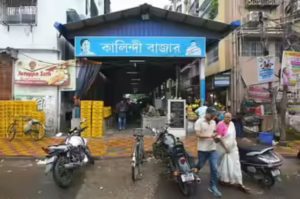Kalindi Housing: Kalindi, or Kalidaha as it was originally known, is a distinctive urban settlement that arose in the late 1970s on the marshy fringes of Patipukur in North Kolkata. It stands today not only as a symbol of vernacular urbanism but also as a testimony to resilience, transformation, and the collective strength of its middle-class Bengali community.

The Genesis of Kalindi Housing
Kalindi emerged at a time when Kolkata’s infrastructure was under significant pressure from a constant influx of people — many of whom were Partition refugees. Designed with a grid layout and standardized flats, Kalindi was initially envisioned as a middle-class housing estate to offer relief to Kolkata’s overcrowded zones.
Shelter Amid Disaster: The 1978 Floods
Before its intended residents could occupy the buildings, the estate opened its doors to those rendered homeless by the devastating floods of 1978. These early days of occupancy, although unplanned, highlighted the estate’s utility during a humanitarian crisis.
Settling In: The Early Years
Families began to move into Kalindi around November 1978. The area lacked basic infrastructure, and even the roads and bus stops were non-existent. Residents took collective action to bring Kalindi onto the city’s map.
Building a Community: The Rise of Cultural Identity
The flats of Kalindi were soon filled by first-generation government employees, clerks, teachers, small traders, and displaced persons — the fabric of an emerging aspirational class. Local publications and collective cultural efforts contributed to a budding sense of identity.


Kalindi’s Urban Aesthetics and Vernacular Planning
According to researcher Sounita Mukherjee, Kalindi represents a form of “planned modernity.” Its layout — uniform, landscaped, and highly structured — stands out from the chaotic urban growth patterns elsewhere in the city.
From Necessity to Comfort: Infrastructure and Amenities
Over the 1980s, the community added essential services. Markets emerged, Durga Puja was celebrated, and civic groups like the Kalindi Bahumukhi Janakalyan Samiti started addressing the community’s medical and social needs
Modern Pressures: Gentrification and Vertical Expansion
With better road connectivity and airport proximity, Kalindi began attracting developers. The first-generation families still occupy flats, but newer multi-storey apartments are rising. Despite this, community bonds remain strong.
Culture Finds a Stage: Kalindi Bratyajon
Kalindi became home to the theatre group ‘Kalindi Bratyajon’ founded by Bratya Basu. The group enriched Kalindi’s identity as not just a residential block but also a cultural nucleus within Kolkata.
Kalindi Housing: A Living Example of Urban Resilience
Kalindi demonstrates that urban growth, when grounded in planning and community effort, can lead to sustainable, inclusive development. It offers a blueprint for how cultural values and social welfare can co-exist in modern cities.
Also read: Home | Channel 6 Network – Latest News, Breaking Updates: Politics, Business, Tech & More

